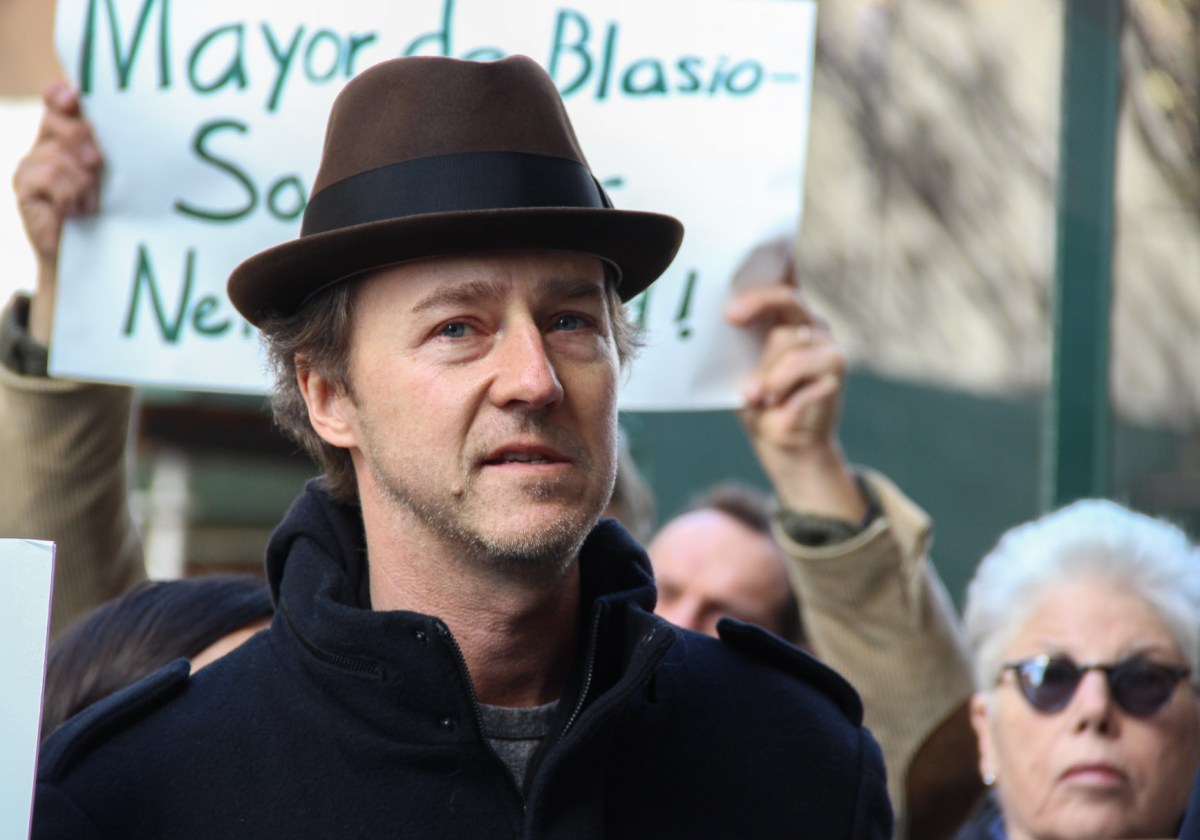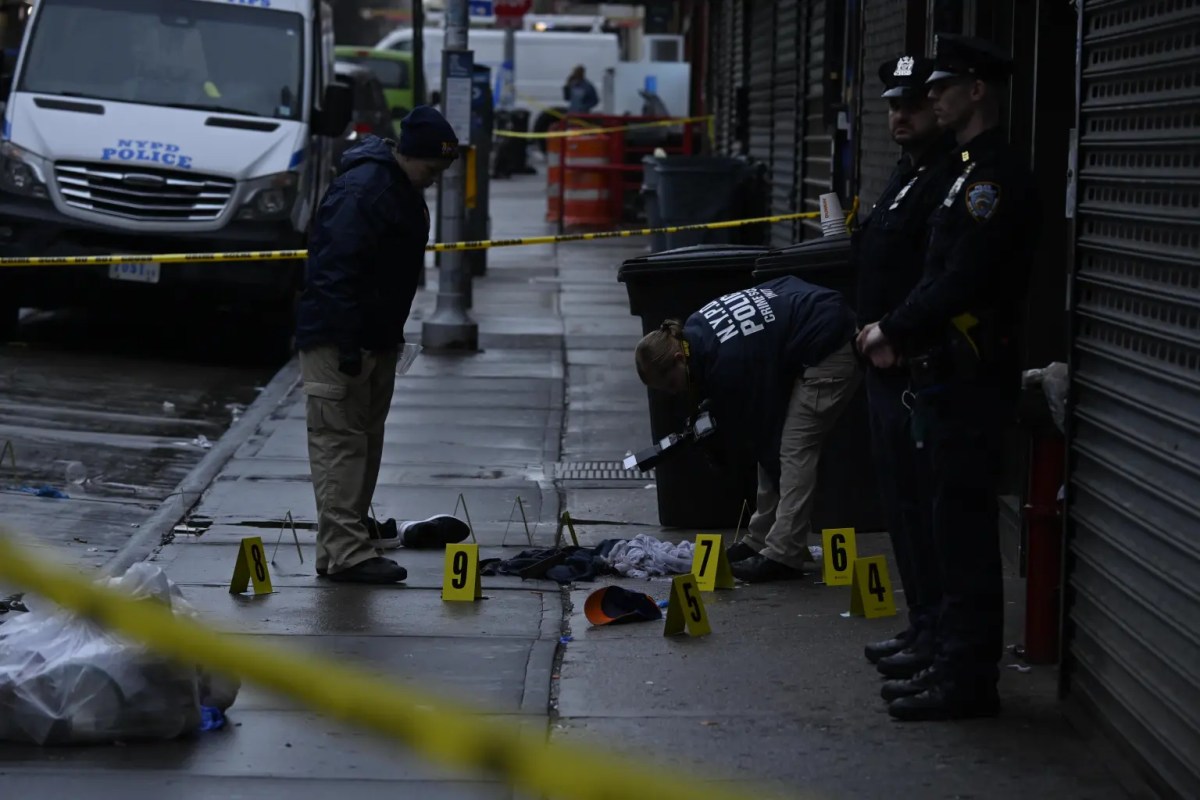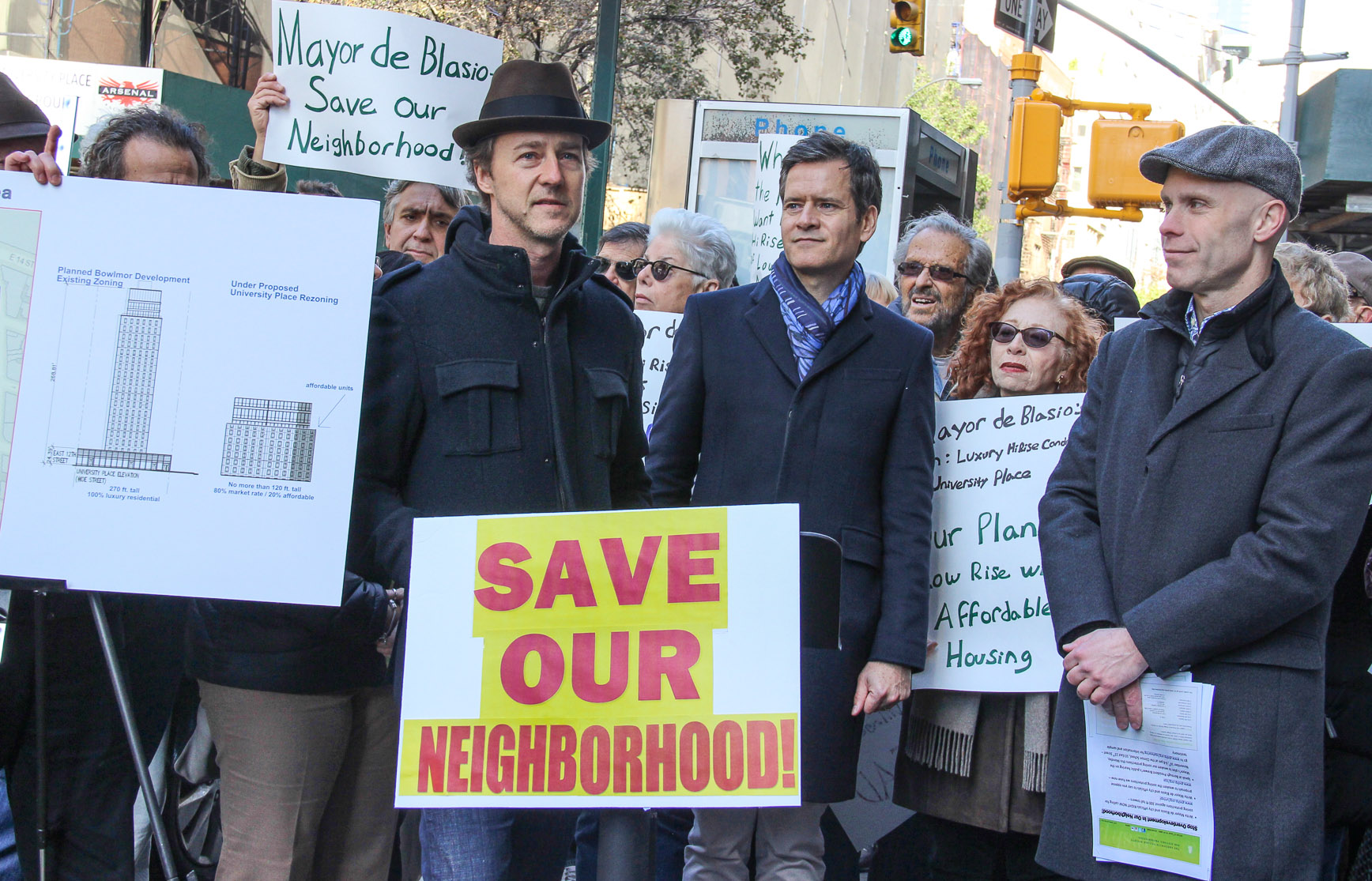
BY LINCOLN ANDERSON | With the city poised to do a major rezoning to allow the massive St. John’s Partners project — with 30 percent affordable housing — to be built on the Lower West Side waterfront, preservationists and activists are crying out that another critically important proposed rezoning has been stuck in limbo for a year. And they are demanding that the de Blasio administration take action now — before it’s too late.
On Sat., Nov. 14, Andrew Berman, executive director of the Greenwich Village Society for Historic Preservation, was joined by local politicians and residents at a press conference at W. 12th St. and University Place, across the street from the former Bowlmor Lanes building, which was shrouded in construction netting and scaffolding. Developer Billy Macklowe plans to construct a nearly 300-foot-tall, 23-story luxury tower, which will be one of the tallest buildings in the Village, on the site, which the historic bowling alley — demolition of which only recently commenced — occupied for 76 years.
Adding extra punch to the group’s message was “Fight Club” actor / activist Edward Norton, who lives nearby.
Specifically, they called for the city to enact a contextual rezoning of the University Place / Broadway corridor that is being pushed by G.V.S.H.P. The plan, covering a 12-block area, would cap future development at 10 to 12 stories (120 feet), plus provide incentives for new projects to have 20 percent affordable housing, under the city’s inclusionary housing program. Currently, this area — dotted with between a dozen and 20 likely future development sites — has no height caps at all.
Were the rezoning applied to Macklowe’s Bowlmor-site project, it would be allowed to rise only 120 feet tall, and there would be strong incentives for it not to be 100 percent market rate, but for one-fifth of its units to be affordable.
If the city adopts the society’s scheme before the Macklowe project is “vested” — meaning work has not yet begun on its foundation — the new zoning would also apply to it. It was, in fact, the Macklowe project that compelled G.V.S.H.P. to advocate for the area’s rezoning.
The overall plan, furthermore, would potentially result in up to 200,000 square feet of affordable housing in the area, according to the preservation society.
The G.V.S.H.P. rezoning is supported by the area’s politicians and Community Board 2. So far, however, Mayor Bill de Blasio’s administration has only given the idea the cold shoulder.
“We are facing a very distressing situation,” Berman said at the Nov. 14 press conference, “a plan to construct a 300-foot-tall building that is completely out of context, completely out of scale for this neighborhood. For more than a year, we have been stonewalled by the city. If the city moves now, we could have a smaller building, and likely with…affordable housing.”
Currently, the nearly two dozen potential development sites in the 12-block area would almost surely become “luxury market-rate high-rise condos, hotels or dorms, which is what the existing zoning allows,” Berman added.
“It is confounding that the mayor is not listening to this,” he said.
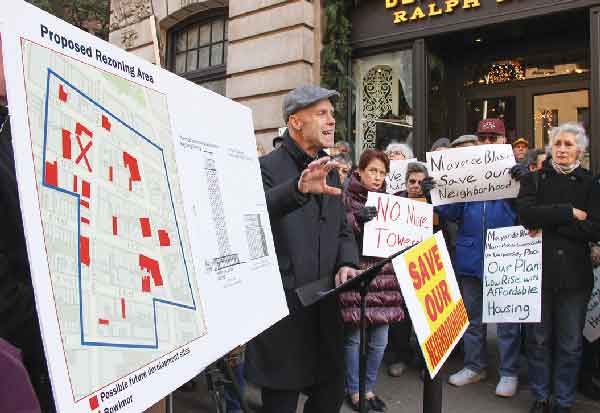
G.V.S.H.P. Director Andrew Berman, above, said projects like the 300-foot-tall Macklowe tower are not appropriate for the University Place / Bowery corridor. Next to him was a map showing the area’s potential “soft sites,” as well as side-by-side renderings showing the proposed project and how it would look under the G.V.S.H.P. rezoning.
Councilmember Rosie Mendez said of the G.V.S.H.P. proposal, “Our community is not 100 percent but 150 percent behind this plan.” Referring to the former Bowlmor building, she said, “110 University Place is, I believe, the first domino that will threaten the architectural integrity and contextuality of our neighborhood.”
A few blocks away, she noted, at the luxury development project at the former Blatt Billiards salesroom and factory, the asking price for the new condos is more than $2,500 per square foot.
“We have enough luxury condos in this city!” she declared, as the crowd applauded. “Many of them sitting empty,” she added. “Use these sites to provide for the community’s enrichment and not the enrichment of the developer.”
State Senator Brad Hoylman stressed, “The city should be listening to our community. This is a community-driven rezoning.
“I still can’t get over that Bowlmor is gone,” he said, noting he lives a block away from the site.
“Instead of Bowlmor, we need to build less,” he emphasized, the pun eliciting an eruption of applause. “Instead of Bowlmor, this tower is going to loom over this amazing corridor that we all walk every day — I walk with our kid — that we walk with our dogs.”
After praising G.V.S.H.P. Director Berman’s work, Norton said, “I’ve lived in this neighborhood for 20 years. Cities change, change is inevitable, it’s not always a bad thing. But what makes New York great is its diversity. It’s not just the people — it’s the diversity in its neighborhoods.
“Greenwich Village is wonderful for reasons that are very particular to it. If you want to live in a condominium, there are places for that. And there are places to do that without compromising the city’s incredible DNA.”
Referring to de Blasio, the actor continued, “It’s hypocritical to position yourself as a populist leader, but perpetually allow development that does not allow affordable housing. You can’t throw up 1-percenter towers all over the city and say that you’re for everybody.”
Norton said there is a “very, very narrow window of time” to persuade the city to adopt the G.V.S.H.P. rezoning and rein in Macklowe’s monster, and he urged people to put on the pressure. However, Hoylman later told The Villager that he didn’t think “Billy’s behemoth” could be stopped at this point.
“No, the die is cast for this building,” Hoylman conceded.
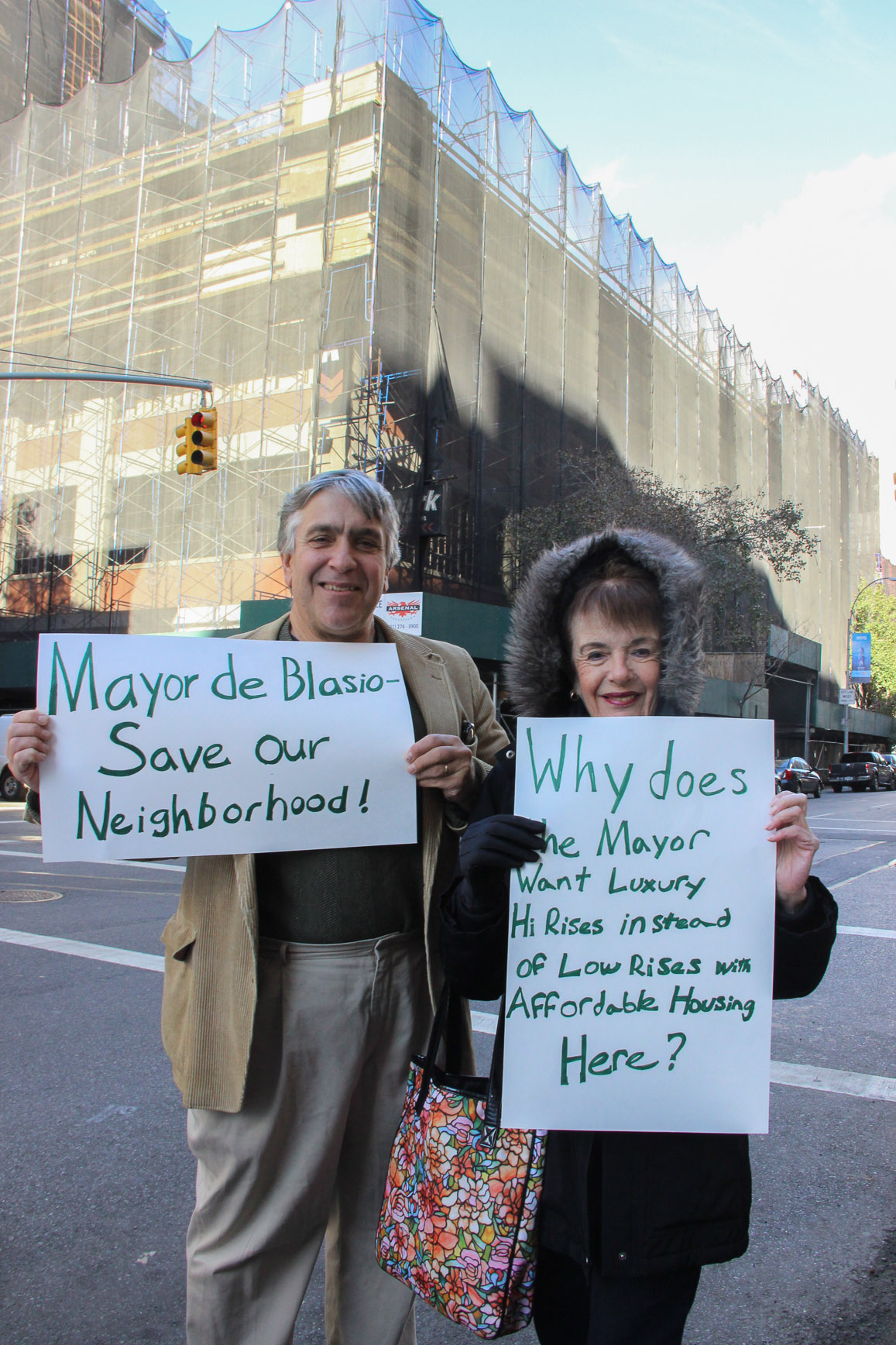
Tobi Bergman, chairperson of Community Board 2, said, “The one thing this area doesn’t need is more shade.” He added that the city’s response — or lack thereof — to the rezoning proposal has been “astounding and confounding.”
“We’re a neighborhood that has to restore our diversity,” he emphasized. “We’ve lost more and more, and this has become a neighborhood for rich people — a high-value neighborhood which is losing diversity. We have to save not just the scale of the neighborhood, but its diversity.”
Bergman said he wants City Hall to work with the Village as “a team.”
“We have a fight going on at Elizabeth St. Garden,” he noted. “It is a beautiful community garden. We need affordable housing. We don’t need it there. The city says they have no place to put affordable housing. Embrace this zoning.
“There are many sites where people would be willing to accept affordable housing if they understand it’s part of teamwork for the community,” Bergman said. “It’s a very small ask with a very big benefit.”
Summing things up, preservationist Berman said, “What the city is saying is, ‘This is O.K. for this neighborhood.’ We’re saying, ‘It’s not O.K. for this neighborhood.’ ”
In January, Berman wrote Carl Weisbrod, the director of the Department of City Planning, advocating for the plan. In July, five local politicians did the same in a joint letter. In August, Weisbrod responded to the pols, countering that, in fact, in the proposed area, “only one site is considered ‘soft’ under standard criteria.”
“While we appreciate your and the community board’s desire to incentivize affordable housing development, [that] would require a much more aggressive increase in permitted densities,” the planning czar wrote. “Such an approach would still not result in a significant number of likely development sites.”
Berman blasted Weisbrod’s response as “totally inaccurate.”
Clarification: Following this article’s publication, Andrew Berman of G.V.S.H.P. contacted The Villager to clarify that he believes the current Macklowe project at the Bowlmor site could be brought under the proposed G.V.S.H.P. rezoning — including a height cap and an affordable housing component — if the city moves fast enough to implement the rezoning.



